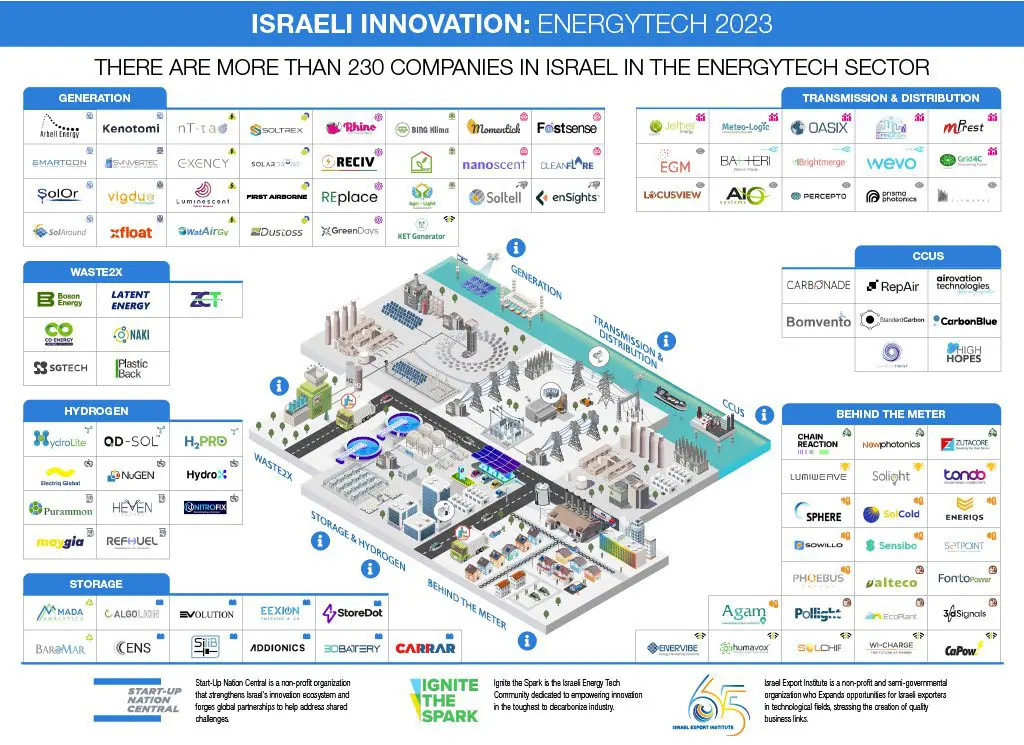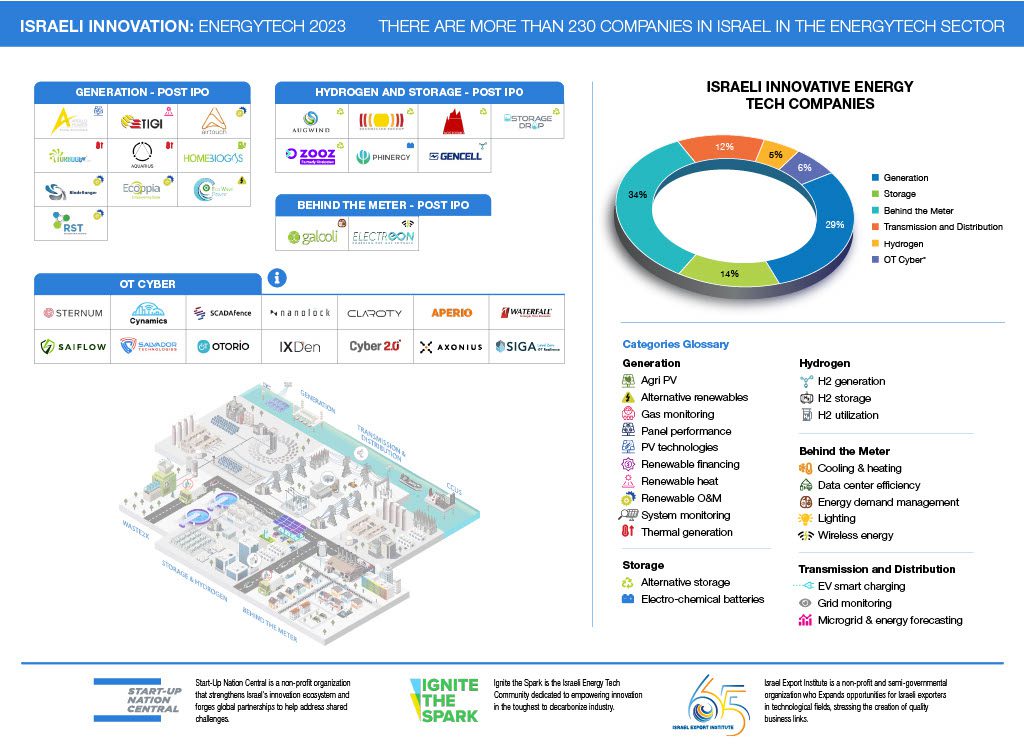The world is at a pivotal moment in the transition to a more sustainable and low-carbon future.
The energy sector, which is responsible for over 70 percent of global greenhouse gas emissions, is a key driver of this transition. The push for cleaner energy systems and technologies is not only driven by climate change concerns but also by the need for energy security and affordability. Energy tech, a subsector of Climate tech, is the response to this demand.
Advanced low-carbon energy systems are integral to climate transition and impact a number of industries. From transportation to manufacturing, construction, and building management, markets seeking EnergyTech innovation have surpassed the traditional energy sector.
Recognizing this opportunity, Israeli entrepreneurs are offering innovative solutions to disrupt all verticals of the new energy value chain.
The Startup Nation: Disrupting the Energy Tech Sector
The Israeli energy tech ecosystem is driven by a strong entrepreneurial spirit, a vibrant startup culture, and a world-class academic and research community. Israel has a long history of innovation and entrepreneurship, which has helped the country become a hub for technology startups.
In recent years, the Israeli energy tech ecosystem has grown significantly, with many new startups and established companies working on a wide range of solutions to bring about the promise of low-carbon energy systems.
From improved renewable energy sources to smart grid management, energy storage, energy efficiency, waste-to-energy, hydrogen, carbon mitigation, and more, Israel is at the forefront of the global energy transition.
Main Players and Big Wins
The Israeli EnergyTech ecosystem is complex and dynamic, with many players working across the energy value chain. Startups and established companies are developing innovative solutions to address specific challenges in the energy sector.
Recognized world leader SolarEdge, a PV inverter manufacturer with a market cap of $15.5 billion, is now moving beyond inverters into advanced energy management systems. Another example is Ormat, the geothermal world leader with a market cap of $5 billion.
One of the most exciting areas of innovation in the Israeli EnergyTech ecosystem is hydrogen. Considered by many as a silver bullet to drive the transition to a low-carbon economy, Israeli startups are developing a range of solutions to produce, store, and transport hydrogen more efficiently and cost-effectively.
One of the leading players in this space is H2Pro, a startup that has raised $75 million in B-round funding. The company’s E-TAC method for producing green hydrogen by splitting water is over 95% efficient, safe, and cost-competitive compared to fossil-fuel hydrogen.
Another area of significant innovation is energy storage, both for electrochemical batteries and alternative storage systems. Israeli startup Addionics raised $27 million in A-round funding in 2022 to improve rechargeable batteries with a novel 3D metal fabrication method. The company’s technology provides performance and cost advantages compared to lithium-ion batteries.
Israel Energy Tech Landscape Map 2023
Startup Nation Central, Ignite the Spark, and the Israel Export Institute produce an energy tech landscape map every year to highlight the breadth and depth of the Israeli energy tech ecosystem.
The 2023 map features over 130 innovative companies that are the backbone of the Israeli energy tech sector. It is dynamic and split into subsectors, making it an easy-to-use tool for learning about the Israeli Energy Technology ecosystem.
Global investors can use the map to find deal flow, while multinational corporations can find solutions to their pain points and decarbonization targets.


EnergyTech Subsectors and Emerging Technologies
Keep reading for a brief overview of eight EnergyTech subsectors featured in the landscape map.
Generation: The process of producing energy from a primary energy source.
Innovative technologies propel the adoption of renewable energy sources such as wind, solar, and hydropower instead of non-renewable (and carbon-heavy) fossil fuels. These technologies have seen significant growth in recent years as the demand for clean energy has increased.
Storage: The process of capturing and storing energy for later use.
Large-scale battery storage, which is becoming increasingly cost-effective, is one emerging technology in this subsector. Others include pumped hydro storage, which uses excess energy to pump water uphill to a storage reservoir and then releases it to generate electricity when needed, and thermal energy storage, which stores heat or cold for later use.
Usage: The application of energy to perform work is usage.
This subsector includes electric vehicles, which are becoming more affordable and efficient, and are powered by renewable energy sources, smart buildings, which use sensors and automation to optimize energy use, and efficient appliances and lighting.
Transmission and Distribution: The delivery of energy from the generation source to the end user through a network of transmission lines and distribution systems.
Sustainability-focused technology in this subsector includes digital grids, which use advanced sensors, analytics, and automation to optimize energy distribution and reduce waste, and microgrids, which are small-scale power grids that can operate independently or in conjunction with the main power grid and can integrate renewable energy sources and storage systems.
Behind the Meter: Technologies associated with consumer-based electricity consumption (and use of other forms of energy).
Innovation related to Behind the Meter applications impacts the output of energy from consumers, optimizing the energy needed for appliances and other consumer goods to perform work. This subsector includes electric vehicles, which are becoming more affordable and efficient, wireless energy, which replaces physical infrastructure, smart buildings, which use sensors and automation to optimize energy use, and efficient appliances and lighting.
Hydrogen: This clean energy carrier can be produced through the electrolysis of water using renewable energy sources such as solar or wind power.
Hydrogen has potential applications in transportation, power generation, and industrial processes. Emerging technologies in this subsector include hydrogen fuel cells, which convert hydrogen into electricity and produce only water as a byproduct, and green hydrogen, which is produced using renewable energy sources and is seen as a key technology for decarbonizing heavy industries such as steel and cement.
Waste2X: This describes processes that convert waste materials into energy or other useful products.
For years waste has been a burden and caused environmental challenges and extensive pollution. By harnessing novel technologies like anaerobic, digestion, pyrolysis, and gasification, both organic and inorganic waste can now be reused and become a sustainable source of electricity, hydrogen, and E-fuels
OT Cyber: This subsector includes cybersecurity measures and technologies that protect operational technology (OT) systems, such as those used in the energy sector, from cyber-attacks and other security threats.
Blockchain, which can provide secure and transparent data sharing and transactions between energy producers and consumers, and artificial intelligence (AI), which can be used to monitor and detect cyber threats in real time, are some of the technologies being leveraged for OT Cyber Tech.
Other developments include distributed energy resources (DERs) such as rooftop solar panels and home batteries, which can be integrated into the grid and controlled using advanced OT systems.
The 2023 EnergyTech Landscape Map reflects the rapid pace of innovation in the Israeli EnergyTech ecosystem across these verticals with useful interactive information on each subsector.
